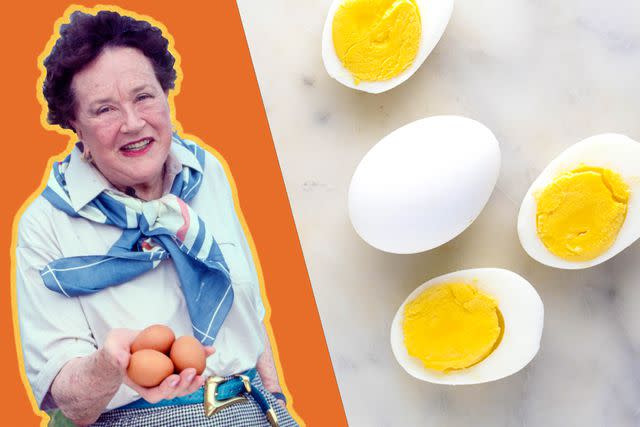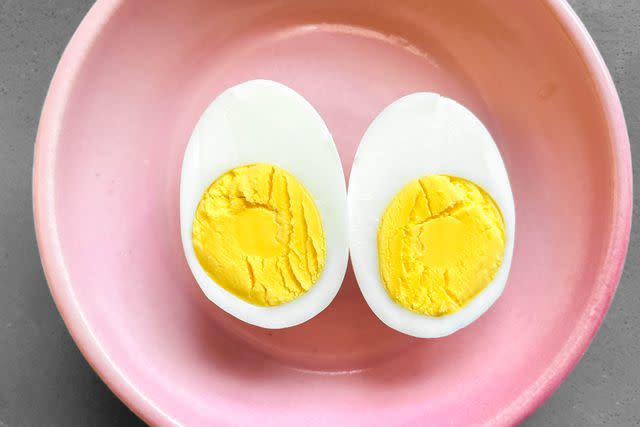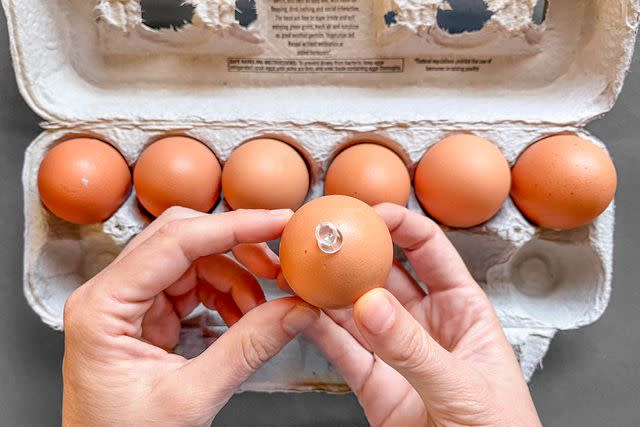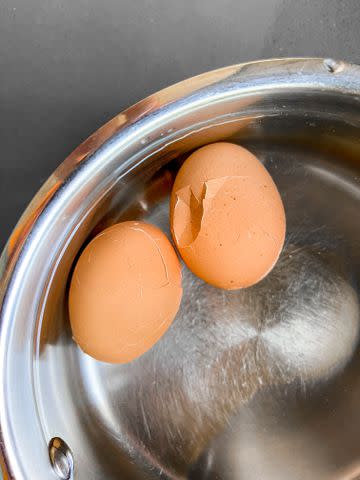Julia Child's Trick for the Perfect Hard Boiled Eggs
- Oops!Something went wrong.Please try again later.
The master of French cooking never boiled eggs without doing this one thing first.
When I think of Julia Child, I think of her dancing a raw turkey around her kitchen counter. I also think of classic French dishes, the likes of which she wrote several cookbooks about and prepared faithfully on her television shows.
Hard boiled eggs may not be the first thing to spring to mind, but Julia was also a master of basics. She dutifully studied and tested methods to ensure she offered up foolproof tips to her readers. In fact, she dedicates a whole section to hard boiled eggs in her classic cookbook, From Julia Child’s Kitchen.

Simply Recipes / Photo Illustrated by Wanda Abraham / Getty Images
I was recently thumbing through the fat cookbook when I found myself reading the “Hard-boiled eggs—the whys and hows” section all the way through. It was packed with clever tips, one of which has changed the way I make hard boiled eggs forever.
Read More: How to Make Perfect Hard Boiled Eggs

Simply Recipes / Laurel Randolph
The Trick to No-Fail Hard Boiled Eggs
A common issue with hard boiled eggs is that they are prone to crack while cooking, causing the whites to leak, making them hard to peel, and creating a less-than-perfect-looking boiled egg. Luckily, Julia has a foolproof way to prevent this issue.
To relieve pressure inside the egg, create a tiny hole in the air pocket at the bottom of the egg (the wider end). Julia recommends using an egg pricker or, if you’re not into retro single-use gadgets, a push pin. Insert the point into the base of the egg about 3/8 of an inch. The tiny hole won’t let any white escape but will relieve pressure from any cracks and keep the egg fully intact.
My Tip for This Egg Trick
If pushing a pin into a raw egg makes you nervous, you’re not alone. I’ve found the easiest way to do this is to turn the egg over in the carton, so you don’t have to hold it steady in your hands. Place the pin in the center of the bottom of the egg facing straight up and push. Believe it or not, I haven’t had an egg break this way yet.

Simply Recipes / Laurel Randolph
I don’t have any real science to back this up, but something I’ve noticed when using this method is the eggs seem easier to peel. I think there’s something about relieving a bit of the pressure inside the eggs that helps the whites separate from the shell.
Bonus Hard Boiled Egg Tips
Julia has plenty of other tips for cooking and peeling hard boiled eggs. Two that stuck out to me and that I’ve added to my egg-cooking routine are:
Crack the shells right after cooking. As soon as you drain the eggs and before topping with cold water or transferring to an ice bath, give them a gentle tap all around on the counter. This is tricky since the eggs are hot—I grab them one at a time with a kitchen towel. I have found that the eggs peel more cleanly after sitting in cold water with cracked shells. Be gentle, though, or you’ll end up with dented eggs!
Let the eggs sit in cold water for longer. While you can peel the eggs as soon as they are cool enough to handle, Julia recommends letting them sit for a while and even putting the eggs in cold water in the fridge for an hour before peeling. This helps the whites firm up, making them less likely to stick to the shell as you peel.
Read More: 16 Recipes to Use Up Those Leftover Hard Boiled Eggs

Simply Recipes / Laurel Randolph
Read the original article on Simply Recipes.

